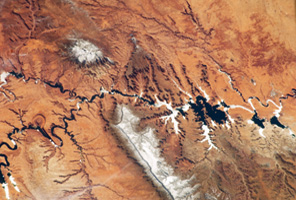By Tony Perry, Los Angeles Times
May 28, 2013
 SAN DIEGO — Officials in the seven states that depend on the drought-beset Colorado River expressed a cautious willingness Tuesday to join the federal government in a complex, possibly contentious effort to step up conservation.
SAN DIEGO — Officials in the seven states that depend on the drought-beset Colorado River expressed a cautious willingness Tuesday to join the federal government in a complex, possibly contentious effort to step up conservation.
At a meeting in San Diego, officials of the Department of the Interior and the Bureau of Reclamation announced the establishment of three inter-state committees to devise plans for conservation, possibly including water reuse, desalination, water banking and the sale of water from farms to cities.
“While the solutions won’t be easy for anyone involved, the consequences of failure are too dire to ignore,” said Patricia Mulroy, general manager of the Southern Nevada Water Authority.
The committees have been ordered to have their recommendations ready by year’s end — virtually lightning speed for water-sharing issues that regularly take years, often decades, to resolve, if they can be resolved at all.
One committee will be composed of major municipal and industrial water users, one of agricultural interests, and one will have representatives from environmental groups. Also, the federal government is pledging to work on conservation projects with 10 American Indian tribes that have rights to the Colorado River and its tributaries.
On one point, there appears to be no disagreement: The hour is late and shortages loom as demand threatens to outstrip supply. Last year was the fifth driest on record; this year is headed to be the fourth driest.
By Oct. 1, the river’s two reservoirs, Lake Mead and Lake Powell, could be at less than half of their capacity, according to the Bureau of Reclamation.
“The time for action is now,” said Jennifer Pitt, head of the Environmental Defense Fund’s Colorado River Project. “Communities that depend on the Colorado River — for water supply or as the foundation of a $26-billion recreation economy — cannot afford to wait.”
Continue reading at the Los Angeles Times.

